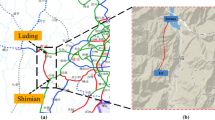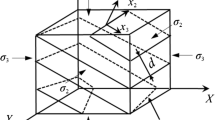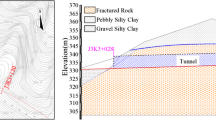Abstract
The stability of an underground tunnel excavated in a jointed rock mass is studied using the field investigation and numerical modelling. This research aims to numerically analyze the rockmass behavior as a function of closely spaced non-persistent joints. For this purpose, the Kainchi-mod Nerchowck twin tunnels (Himachal Pradesh, India) is chosen for the in-depth analysis. The host rock encountered is mainly gray sandstone and maroon sandstone with many closely spaced, non-persistent joints, dipping critically into the tunnel. The detailed rockmass properties were collected from the field and intact rock properties were tested in the laboratory. A series of finite element numerical simulations were conducted based on the filed/laboratory data with different values of joint spacing, including the actual values of field joint spacing. It was found that the extent of deformation above the excavation was predominantly controlled by the joint spacing. The results of this study provide an explicit correlation between geometrical features of the rock mass with the total displacement values around the excavation. The study will help the engineers to design an appropriate support system for heavily jointed rocmkass.












Similar content being viewed by others
References
Abdellah WR, Ali MA, Yang HS (2018) Studying the effect of some parameters on the stability of shallow tunnels. J Sustain Min 17:20–33. https://doi.org/10.1016/j.jsm.2018.02.001
Ameri M, Yavari N, Scullion T (2009) comparison of static and dynamic back calculation of flexible pevment layer modulli, using four software program. J Chem Inf Model 2:197–210. https://doi.org/10.1017/CBO9781107415324.004
ASTM:D7012–14 (2014) Standard test methods for compressive strength and elastic moduli of intact rock core specimens under varying states of stress and temperatures. ASTM Int. https://doi.org/10.1520/D7012-14E01
ASTM:E132–04(10) (2011) Standard test method for poisson’s ratio at room temperature. ASTM Int 4:2010–2012. https://doi.org/10.1520/E0132-04R10.2
ASTM (1985) Standard test method for determination of the point load strength index of rock. Rock Mech 22:1–9. https://doi.org/10.1520/D5731-08.2
Bahaaddini M, Hagan P, Mitra R, Hebblewhite BK (2016) Numerical study of the mechanical behavior of nonpersistent jointed rock masses. Int J Geomech 16:1–10. https://doi.org/10.1061/(ASCE)GM.1943-5622.0000510
Barton N (1976) The shear strength of rock and rock joints. Int J Rock Mech Min Sci Geomech Abstr 13:255–279. https://doi.org/10.1016/0148-9062(76)90003-6
Barton N (1973) Review of a new shear-strength criterion for rock joints. Eng Geol 7:287–332. https://doi.org/10.1016/0013-7952(73)90013-6
Barton N, Choubey V (1977) The shear strength of rock joints in theory and practice. Rock Mech 10:1–54. https://doi.org/10.1007/BF01261801
Bieniawski ZT (1989) Engineering rock mass classifications: a complete manual for engineers and geologists in mining, civil, and petroleum engineering Eng rock mass Classif a Complet Man Eng Geol mining, civil, Pet Eng 251
Bobet A, Fakhimi A, Johnson S, Morris J, Tonon F, Yeung MR (2009) Numerical models in discontinuous media: review of advances for rock mechanics applications. J Geotech Geoenvironmental Eng 135:1547–1561. https://doi.org/10.1061/(ASCE)GT.1943-5606.0000133
Boon CW, Houlsby GT, Utili S (2014) Designing tunnel support in jointed rock masses via the DEM. Rock Mech Rock Eng 48:603–632. https://doi.org/10.1007/s00603-014-0579-8
Brady BHG (1977) An analysis of rock behaviour in an experimental stoping block at the Mount Isa Mine, Queensland, Australia. Int J Rock Mech Min Sci 14:59–66. https://doi.org/10.1016/0148-9062(77)90197-8
Brown ET (1981a) Rock characterization testing and monitoring: ISRM suggested methods for determining water content. Porosity, Density, Absorption and Related Properties and Swelling and Slake-Durability Index Properties, pp 81–89
Brown ET (1981b) Rock characterization, testing & monitoring: ISRM suggested methods. Published for the Commission on Testing Methods, International Society for Rock Mechanics by Pergamon Press
Carroll WF (1998) A primer for finite elements in elastic structures. John Wiley & Sons, Hoboken
Das R, Singh PK, Kainthola A, Panthee S, Singh TN (2017) Numerical analysis of surface subsidence in asymmetric parallel highway tunnels. J Rock Mech Geotech Eng 9:170–179. https://doi.org/10.1016/j.jrmge.2016.11.009
Das R, Singh TN (2020) Effect of rock bolt support mechanism on tunnel deformation in jointed rockmass: a numerical approach. Undergr Sp. https://doi.org/10.1016/j.undsp.2020.06.001
Das R, Sirdesai NN, Singh TN (2017b) Analysis of Deformational Behavior of Circular Underground Opening in Soft Ground Using Three-Dimensional Physical Model. In: American Rock Mechanics Association ARMA 2017, 51st US Rock Mechanics / Geomechanics Symposium. San Francisco, California, USA
Fan X, Kulatilake PHSW, Chen X (2015) Mechanical behavior of rock-like jointed blocks with multi-non-persistent joints under uniaxial loading: a particle mechanics approach. Eng Geol 190:17–32. https://doi.org/10.1016/j.enggeo.2015.02.008
Fuenkajorn K, Phueakphum D (2010) Physical model simulation of shallow openings in jointed rock mass under static and cyclic loadings. Eng Geol 113:81–89. https://doi.org/10.1016/j.enggeo.2010.03.003
Hoek E, Brown ET (1997) Practical estimates of rock mass strength. Int J Rock Mech Min Sci 34:1165–1186. https://doi.org/10.1016/S1365-1609(97)80069-X
Hoek E, Carranza-Torres C, Corkum B, Diederichs MS, Corkum B (2008) The 2008 Kersten Lecture, Intergration of geotechnical and structural design in tunnelling. 56th Annu Geotech Eng Conf 54
Hoek E, Carranza C, Corkum B (2002) Hoek-brown failure criterion – 2002 edition. Narms-Tac 267–273. doi: https://doi.org/10.1016/0148-9062(74)91782-3
Jaeger JC, Cook NGW, Zimmerman RW (2007) Fundamentals of rock mechanics. Blackwell publishing, Forth
Jia P, Tang CA (2008) Numerical study on failure mechanism of tunnel in jointed rock mass. Tunn Undergr Sp Technol 23:500–507. https://doi.org/10.1016/j.tust.2007.09.001
Kirsch EG (1898) Die theorie der elastizität und die bedürfnisse der festigkeitslehre. Zeitschrift des Vereines Dtsch Ingenieure 42:797–807
Kuszmaul JS (1999) Estimating keyblock sizes in underground excavations: accounting for joint set spacing. Int J Rock Mech Min Sci 36:217–232. https://doi.org/10.1016/S0148-9062(98)00184-3
Lee YK, Pietruszczak S (2008) A new numerical procedure for elasto-plastic analysis of a circular opening excavated in a strain-softening rock mass. Tunn Undergr Sp Technol 23:588–599. https://doi.org/10.1016/j.tust.2007.11.002
Li Y, Zhou H, Zhu W, Li S, Liu J (2016) Experimental and numerical investigations on the shear behavior of a jointed rock mass. Geosci J 20:371–379. https://doi.org/10.1007/s12303-015-0052-z
Madkour H (2012) Parametric analysis of tunnel behavior in jointed rock. Ain Shams Eng J 3:79–103. https://doi.org/10.1016/j.asej.2012.01.002
Nikadat N, Fatehi Marji M, Rahmannejad R, Yarahmadi Bafghi A (2016) Effect of joint spacing and joint dip on the stress distribution around tunnels using different numerical methods. J African Earth Sci 123:193–209. https://doi.org/10.1016/j.jafrearsci.2016.07.025
Panthee S, Singh PK, Kainthola A, Das R, Singh TN (2018a) Comparative study of the deformation modulus of rock mass. Bull Eng Geol Environ 77:751–760. https://doi.org/10.1007/s10064-016-0974-3
Panthee S, Singh PK, Kainthola A, Das R, Singh TN (2018b) Comparative study of the deformation modulus of rock masses—a reply to the comments received from Gokceoglu (2018). Bull Eng Geol Environ 77:763–766. https://doi.org/10.1007/s10064-018-1272-z
Panthee S, Singh PK, Kainthola A, Singh TN (2016) Control of rock joint parameters on deformation of tunnel opening. J Rock Mech Geotech Eng 8:489–498. https://doi.org/10.1016/j.jrmge.2016.03.003
Panthi KK (2012) Evaluation of rock bursting phenomena in a tunnel in the Himalayas. Bull Eng Geol Environ 71:761–769. https://doi.org/10.1007/s10064-012-0444-5
Rocscience Inc. (2016) Phase2 v.8, Tutorial Manual, Available from www.rocscience.com.
Sazid M (2017) Effect of underground blasting on surface slope stability: a numerical approach. Am J Min Metall 4:32–36. https://doi.org/10.12691/ajmm-4-1-2
Sazid M, Ahmed HA (2019) Stability analysis of shallow depth tunnel in weak rock mass: 3d numerical modeling approach. J City Dev 1:18–22. https://doi.org/10.12691/jcd-1-1-3
Sellers EJ, Klerck P (2000) Modelling of the effect of discontinuities on the extent of the fracture zone surrounding deep tunnels. Tunn Undergr Sp Technol 15:463–469. https://doi.org/10.1016/S0886-7798(01)00015-3
Shen B, Barton N (1997) The disturbed zone around tunnels in jointed rock Masses. Int J Rock Mech Min Sci 34:117–125. https://doi.org/10.1016/S1365-1609(97)80037-8
Singh B, Goel RK (2011) Engineering rock mass classification tunneling, foundations, and landslides. Elsevier, Edinburgh London New York Oxford Philadelphia St Louis Sydney Toronto
Singh PK, Das R, Singh KK, Singh TN (2016) Landslide in fractured and stratified rocks - a case from Aizawl, Mizoram, India. In: Proceedings of the conference on Recent Advances in Rock Engineering (RARE 2016). Atlantis Press, Paris, France, pp 189–194
Singh PK, Wasnik AB, Kainthola A, Sazid M, Singh TN (2013) The stability of road cut cliff face along SH-121: a case study. Nat Hazards 68:497–507. https://doi.org/10.1007/s11069-013-0627-9
Tsesarsky M, Hatzor YH (2006) Tunnel roof deflection in blocky rock masses as a function of joint spacing and friction - a parametric study using discontinuous deformation analysis (DDA). Tunn Undergr Sp Technol 21:29–45. https://doi.org/10.1016/j.tust.2005.05.001
Wang X, Zhao Y, Lin X (2011) Determination of mechanical parameters for jointed rock masses. J Rock Mech Geotech Eng 3:398–406. https://doi.org/10.3724/SP.J.1235.2011.00398
Yang F, Zhang J, Yang J, Zhao L, Zheng X (2015) Stability analysis of unlined elliptical tunnel using finite element upper-bound method with rigid translatory moving elements. Tunn Undergr Sp Technol 50:13–22. https://doi.org/10.1016/j.tust.2015.06.005
Yang J, Liu C, Chen Q, Xie X (2017) Performance of overlapped shield tunneling through an integrated physical model tests, numerical simulations and real-time field monitoring. Undergr Sp 2:45–59. https://doi.org/10.1016/j.undsp.2017.04.002
Yang SQ, Yin PF, Zhang YC, Chen M, Zhou XP, Jing HW, Zhang QY (2019) Failure behavior and crack evolution mechanism of a non-persistent jointed rock mass containing a circular hole. Int J Rock Mech Min Sci 114:101–121. https://doi.org/10.1016/j.ijrmms.2018.12.017
Yang Y, Xie X, Wang R (2010) Numerical simulation of dynamic response of operating metro tunnel induced by ground explosion. J Rock Mech Geotech Eng 2:373–384. https://doi.org/10.3724/SP.J.1235.2010.00373
Yeung MR, Leong LL (1997) Effects of joint attributes on tunnel stability. Int J rock Mech Min Sci Geomech Abstr 34:505. https://doi.org/10.1016/S1365-1609(97)00286-4
Zhang L (2013) Engineering properties of rocks. J Chem Inf Model 53:1689–1699. https://doi.org/10.1017/CBO9781107415324.004
Zhang W, Xu B, Mei J, Yue G, Shi W (2020) A numerical study on mechanical behavior of jointed rock masses after tunnel excavation. Arab J Geosci 13:1–12. https://doi.org/10.1007/s12517-020-05358-y
Zhang Z, Chen F, Li N, Swoboda G, Liu N (2017) Influence of fault on the surrounding rock stability of a tunnel: location and thickness. Tunn Undergr Sp Technol 61:1–11. https://doi.org/10.1016/j.tust.2016.09.003
Acknowledgements
This research was conducted in Rock Science and Rock Engineering (RSRE) laboratory in the Department of Earth Sciences, Indian Institute of Technology Bombay. We also thank the anonymous reviewers for their constructive comments which helped to modify the manuscript in current form.
Author information
Authors and Affiliations
Corresponding author
Ethics declarations
Conflict of Interest
The authors declare that there is no conflict of interest.
Additional information
Publisher's Note
Springer Nature remains neutral with regard to jurisdictional claims in published maps and institutional affiliations.
Rights and permissions
About this article
Cite this article
Das, R., Singh, T.N. Effect of Closely Spaced, Non-Persistent Ubiquitous Joint on Tunnel Boundary Deformation: A Case Study from Himachal Himalaya. Geotech Geol Eng 39, 2447–2459 (2021). https://doi.org/10.1007/s10706-020-01637-3
Received:
Accepted:
Published:
Issue Date:
DOI: https://doi.org/10.1007/s10706-020-01637-3




